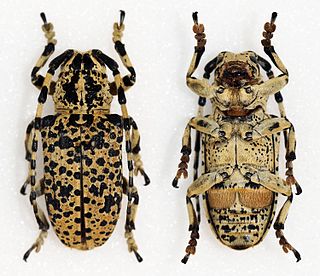
Angophora is a genus of nine species of trees and shrubs in the myrtle family, Myrtaceae. Endemic to eastern Australia, they differ from other eucalypts in having juvenile and adult leaves arranged in opposite pairs, sepals reduced to projections on the edge of the floral cup, four or five overlapping, more or less round petals, and a papery or thin, woody, often strongly ribbed capsule. Species are found between the Atherton Tableland in Queensland and south through New South Wales to eastern Victoria, Australia.

Hygrophila costata, with the common names glush weed, gulf swampweed, and yerba de hicotea, is an aquatic plant.

Ipomoea costata, commonly known as rock morning glory, is an Australian native plant. It is found in northern Australia, from Western Australia, through the Northern Territory, to Queensland. Its tubers provide a form of bush tucker to some Aboriginal peoples, known as bush potato, or, karnti.

Angophora costata, commonly known as Sydney red gum, rusty gum or smooth-barked apple, is a species of tree that is endemic to eastern Australia. Reaching 30 m (100 ft) in height, the species has distinctive smooth bark that is pinkish or orange-brown when new and fades to grey with age. Its lance-shaped leaves are arranged in opposite pairs along the stems, with white or creamy white flowers appearing from October to December. The flower buds are usually arranged in groups of three, followed by ribbed, oval or bell-shaped fruit.
The Broken Heart is a Caroline era tragedy written by John Ford, and first published in 1633. "The play has long vied with 'Tis Pity She's a Whore as Ford's greatest work...the supreme reach of his genius...." The date of the play's authorship is uncertain, and is generally placed in the 1625–32 period by scholars. The title page of the first edition states that the play was acted by the King's Men at the Blackfriars Theatre. The text is preceded by the motto "Fide Honor," an anagram for "John Forde," which Ford employs in other of his plays as well. The volume was dedicated to William Lord Craven, Baron of Hampsteed-Marshall.

Anisoptera costata is an endangered species of plant in the family Dipterocarpaceae. The name costata is derived from Latin and describes the prominent venation of the leaf blade. A huge emergent tree up to 65 m high, it is found in evergreen and semi-evergreen lowland tropical seasonal forests of Indo-Burma and in mixed dipterocarp forests of Malesia.

Penthea is a genus of longhorn beetles of the subfamily Lamiinae, containing the following species:
Penthea intricata is a species of beetle in the family Cerambycidae. It was described by Francis Polkinghorne Pascoe in 1864. It is known to be from Australia.
Penthea macularia is a species of beetle in the family Cerambycidae. It was described by Francis Polkinghorne Pascoe in 1867. It is known from Australia.
Penthea melanosticta is a species of beetle in the family Cerambycidae. It was described by Francis Polkinghorne Pascoe in 1875. It is known from Australia.
Penthea militaris is a species of beetle in the family Cerambycidae. It was described by Francis Polkinghorne Pascoe in 1863. It is known from Australia.
Penthea pullina is a species of beetle in the family Cerambycidae. It was described by Francis Polkinghorne Pascoe in 1863. It is known from Australia.
Penthea scenica is a species of beetle in the family Cerambycidae. It was described by Francis Polkinghorne Pascoe in 1863. It is known from Australia.
Penthea solida is a species of beetle in the family Cerambycidae. It was described by Francis Polkinghorne Pascoe in 1863. It is known from Australia.
Penthea saga is a species of beetle in the family Cerambycidae. It was described by Francis Polkinghorne Pascoe in 1865. It is known from Australia.
Penthea lichenosa is a species of beetle in the family Cerambycidae. It was described by McKeown in 1942. It is known from Australia.
Penthea pardalina is a species of beetle in the family Cerambycidae. It was described by Stephan von Breuning in 1942.

Penthea pardalis is a species of beetle in the family Cerambycidae. It was described by Newman in 1842. It is known from Australia. It contains the varietas Penthea pardalis var. occidentalis.
Penthea tigrina is a species of beetle in the family Cerambycidae. It was described by Thomas Blackburn in 1901. It is known from Australia.
Penthea vermicularia is a species of beetle in the family Cerambycidae. It was described by Edward Donovan in 1805. It is known from Australia. It feeds on Acacia decurrens.





